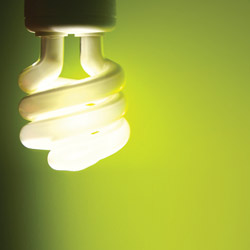
Today’s business community has adopted a new maxim: energy efficiency is just plain good business.
Those businesses that aggressively embrace energy efficiency are reaping a wide variety of benefits. These benefits not only include reduced energy consumption and lower energy bills, but also improved employee comfort and productivity and reduced carbon footprints. Furthermore, businesses that succeed in reining in energy costs find that their initiative provide them a distinct competitive advantage.
Lighting is one area in which most businesses can realize immediate returns on their energy efficiency investments. Lighting improvements can be as simple as replacing incandescent lights with compact fluorescent lights (CFLs). Energy Star-qualified lighting uses up to 75 percent less energy than conventional lighting and lasts up to 10 times longer.
Another lighting area that can yield big savings begins with the ubiquitous T12 fluorescent tube. This old workhorse is being put out to pasture. Rendered obsolete, the T12 will not be manufactured after 2011, and supplies in many areas already are limited. Business owners can quickly begin reaping savings by replacing T12 lights with high-efficiency T8 fluorescent tubes. The T8 fits in the T12 fixture, though older magnetic ballasts must be replaced with modern electronic ballasts.
When installing new lighting, business owners should consider installing the even more efficient T5 fluorescent light. The T5 produces excellent light at a lower cost than the T8, but it does require its own unique fixture.
One aspect of lighting that is often ignored is the exit sign. Most businesses have at least three to four such signs. By replacing an older sign illuminated by an incandescent bulb with a modern LED (light-emitting diode), business owners can realize energy savings of about $60 per sign per year.
Another critical area is heating and air conditioning. Business owners can take a large bite out of their energy bills by replacing older, inefficient equipment with new, high-efficiency heating and cooling units or, where possible, by switching to geothermal heat pumps. Of course, many businesses may find it is not necessary to replace existing heating and cooling systems. Rather, their equipment may only need a tune-up, and ducts may need to be sealed to maximize efficiency.
Then there are the so-called “small” items. These are easy to address, but costly to ignore. Business owners need to find and eliminate air leaks around doors, windows and exterior wall outlets. In most cases, a little silicone caulk or wall outlet insulation will do the job. Many older and even some newer buildings lack adequate insulation, a deficiency that can usually be easily corrected. Turning the water heater to 120° Fahrenheit or the “low” setting can reduce energy costs, as can nozzles that restrict the flow of water.
While businesses recognize the importance of energy efficiency, it is not at all unusual for owners to wonder whether they can afford the cost of high-efficiency lights and equipment. Certainly, the savings generated by energy efficiency will offset the cost of these improvement projects in a relatively short period of time. But energy efficiency has become even more affordable for downstate Illinois businesses that are customers of Ameren Illinois.
The Act On Energy initiative offers a wide range of financial incentives and rebates for businesses. During the first year of the program, Act On Energy helped businesses achieve 54 million kilowatt-hours in energy savings, an amount equivalent to the electricity used by nearly 5,000 single-family homes in one year. Those businesses realized $4.8 million in annual electric savings.
Complete business program information is available at ActOnEnergy.com, by calling 1-866-800-0747 or by sending an email to ActOnEnergyBusiness@ameren.com. iBi

